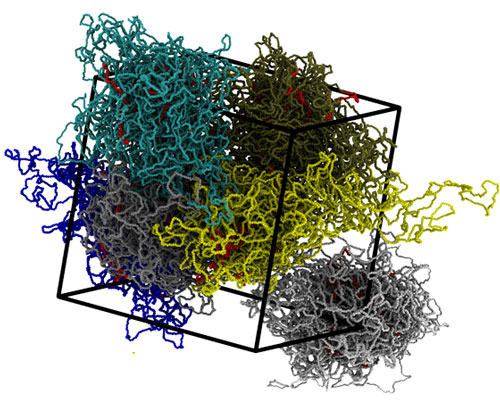| Mar 29, 2013 |
DNA: how to unravel the tangle
|
|
(Nanowerk News) A chromosome is rarely found in the shape we are used to seeing in biology books, that is to say the typical double rod shape (the X pattern, to put it simply). It is usually “diluted” in the nucleus and creates a bundle that under the microscope appears as a messy tangle. In the last few years such chaos, however, has been “measured” and scientists have unveiled their secret: the genes in the tangle are actually arranged in regions that may perform a functional role. A research coordinated by the scientists at SISSA of Trieste has now developed and studied a numeric model of the chromosome that supports the experimental data and provides a hypothesis on the bundle’s function ("Colocalization of Coregulated Genes: A Steered Molecular Dynamics Study of Human Chromosome 19").
|
|
A chromosome spends most of its life “diluted” in the nuclear cytoplasm. To the untrained eye it may look like a randomly entangled thread, yet biologists claim the opposite: although a chaotic component does exist in the bundle, experimental measurements have identified regions that tend to contain specific genes. Thanks to such measurements, researchers have obtained maps of the chromosome in its diluted form, the one in which the DNA transcription processes occur.
|
 |
| Chromosome
|
|
Cristian Micheletti, a physicist of SISSA, the International School for Advanced Studies of Trieste, has coordinated an international research team - in which Marco Di Stefano and Angelo Rosa stand out - that has devised an ingenious method which, on one hand, has allowed to verify the already known experimental measures and, on the other, to find data in support of a theory which explains why the DNA bundle is arranged in regions.
|
|
“Employing the vast amount of publicly available data on gene expression, we have identified families of genes co-regulated within a chromosome” explains Micheletti. The co-regulated genes codify “in accord”, but how such synchronization occurs is a mystery, since often the genes are located very far from one another on the DNA filament. “Two main hypotheses may be considered: either ‘messengers’ exist that travel back and forth from one gene to the other and coordinate the activity, or the DNA filament folding up inside the tangle brings the genes belonging to the same family physically close.”
|
|
On the basis of the second assumption Micheletti and his colleagues have used the computer to induce the DNA numeric model to bring the co-regulated genes closer. “The outcome of the simulation has provided a map of chromosome arrangement that is very close to the one obtained through experimentation,” explains Micheletti. “Besides, the model has successfully brought closer the genes belonging to the same family, as we had asked for, in 80% of cases, that is without too much effort, which corroborates the validity of the hypothesis and the effectiveness of the simulation.”
|

